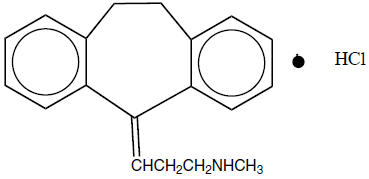Nortriptyline
Editor-In-Chief: C. Michael Gibson, M.S., M.D. [1]; Associate Editor(s)-in-Chief: Pratik Bahekar, MBBS [2]
Disclaimer
WikiDoc MAKES NO GUARANTEE OF VALIDITY. WikiDoc is not a professional health care provider, nor is it a suitable replacement for a licensed healthcare provider. WikiDoc is intended to be an educational tool, not a tool for any form of healthcare delivery. The educational content on WikiDoc drug pages is based upon the FDA package insert, National Library of Medicine content and practice guidelines / consensus statements. WikiDoc does not promote the administration of any medication or device that is not consistent with its labeling. Please read our full disclaimer here.
Black Box Warning
|
Suicidality and Antidepressant Drugs
See full prescribing information for complete Boxed Warning.
Antidepressants increased the risk compared to placebo of suicidal thinking and behavior (suicidality) in children, adolescents, and young adults in short-term studies of major depressive disorder (MDD) and other psychiatric disorders. Anyone considering the use of nortriptyline hydrochloride or any other antidepressant in a child, adolescent, or young adult must balance this risk with the clinical need. Short-term studies did not show an increase in the risk of suicidality with antidepressants compared to placebo in adults beyond age 24; there was a reduction in risk with antidepressants compared to placebo in adults aged 65 and older. Depression and certain other psychiatric disorders are themselves associated with increases in the risk of suicide. Patients of all ages who are started on antidepressant therapy should be monitored appropriately and observed closely for clinical worsening, suicidality, or unusual changes in behavior. Families and caregivers should be advised of the need for close observation and communication with the prescriber. Nortriptyline hydrochloride is not approved for use in pediatric patients.
|
Overview
Nortriptyline is a Tricyclic antidepressant that is FDA approved for the {{{indicationType}}} of {{{indication}}}. There is a Black Box Warning for this drug as shown here. Common adverse reactions include {{{adverseReactions}}}.
Adult Indications and Dosage
FDA-Labeled Indications and Dosage (Adult)
Condition 1
- Dosing Information
- (Dosage)
Off-Label Use and Dosage (Adult)
Guideline-Supported Use
Condition 1
- Developed by: (Organization)
- Class of Recommendation: (Class) (Link)
- Strength of Evidence: (Category A/B/C) (Link)
- Dosing Information/Recommendation
- (Dosage)
Non–Guideline-Supported Use
Condition 1
- Dosing Information
- There is limited information about Off-Label Non–Guideline-Supported Use of Nortriptyline in adult patients.
Pediatric Indications and Dosage
FDA-Labeled Indications and Dosage (Pediatric)
Condition 1
- Dosing Information
- (Dosage)
Off-Label Use and Dosage (Pediatric)
Guideline-Supported Use
Condition 1
- Developed by: (Organization)
- Class of Recommendation: (Class) (Link)
- Strength of Evidence: (Category A/B/C) (Link)
- Dosing Information/Recommendation
- (Dosage)
Non–Guideline-Supported Use
Condition 1
- Dosing Information
- There is limited information about Off-Label Non–Guideline-Supported Use of Nortriptyline in pediatric patients.
Contraindications
- Condition 1
- Condition 2
- Condition 3
- Condition 4
- Condition 5
Warnings
|
Suicidality and Antidepressant Drugs
See full prescribing information for complete Boxed Warning.
Antidepressants increased the risk compared to placebo of suicidal thinking and behavior (suicidality) in children, adolescents, and young adults in short-term studies of major depressive disorder (MDD) and other psychiatric disorders. Anyone considering the use of nortriptyline hydrochloride or any other antidepressant in a child, adolescent, or young adult must balance this risk with the clinical need. Short-term studies did not show an increase in the risk of suicidality with antidepressants compared to placebo in adults beyond age 24; there was a reduction in risk with antidepressants compared to placebo in adults aged 65 and older. Depression and certain other psychiatric disorders are themselves associated with increases in the risk of suicide. Patients of all ages who are started on antidepressant therapy should be monitored appropriately and observed closely for clinical worsening, suicidality, or unusual changes in behavior. Families and caregivers should be advised of the need for close observation and communication with the prescriber. Nortriptyline hydrochloride is not approved for use in pediatric patients.
|
Conidition 1
(Description)
Adverse Reactions
Clinical Trials Experience
Central Nervous System
- (list/description of adverse reactions)
Cardiovascular
- (list/description of adverse reactions)
Respiratory
- (list/description of adverse reactions)
Gastrointestinal
- (list/description of adverse reactions)
Hypersensitive Reactions
- (list/description of adverse reactions)
Miscellaneous
- (list/description of adverse reactions)
Postmarketing Experience
Central Nervous System
- (list/description of adverse reactions)
Cardiovascular
- (list/description of adverse reactions)
Respiratory
- (list/description of adverse reactions)
Gastrointestinal
- (list/description of adverse reactions)
Hypersensitive Reactions
- (list/description of adverse reactions)
Miscellaneous
- (list/description of adverse reactions)
Drug Interactions
- (Drug 1)
- (Description)
- (Drug 2)
- (Description)
- (Drug 3)
- (Description)
Use in Specific Populations
Pregnancy
Pregnancy Category (FDA):
There is no FDA guidance on usage of Nortriptyline in women who are pregnant.
Pregnancy Category (AUS):
There is no Australian Drug Evaluation Committee (ADEC) guidance on usage of Nortriptyline in women who are pregnant.
Labor and Delivery
There is no FDA guidance on use of Nortriptyline during labor and delivery.
Nursing Mothers
There is no FDA guidance on the use of Nortriptyline in women who are nursing.
Pediatric Use
There is no FDA guidance on the use of Nortriptyline in pediatric settings.
Geriatic Use
There is no FDA guidance on the use of Nortriptyline in geriatric settings.
Gender
There is no FDA guidance on the use of Nortriptyline with respect to specific gender populations.
Race
There is no FDA guidance on the use of Nortriptyline with respect to specific racial populations.
Renal Impairment
There is no FDA guidance on the use of Nortriptyline in patients with renal impairment.
Hepatic Impairment
There is no FDA guidance on the use of Nortriptyline in patients with hepatic impairment.
Females of Reproductive Potential and Males
There is no FDA guidance on the use of Nortriptyline in women of reproductive potentials and males.
Immunocompromised Patients
There is no FDA guidance one the use of Nortriptyline in patients who are immunocompromised.
Administration and Monitoring
Administration
There is limited information regarding Nortriptyline Administration in the drug label.
Monitoring
There is limited information regarding Nortriptyline Monitoring in the drug label.
IV Compatibility
There is limited information regarding the compatibility of Nortriptyline and IV administrations.
Overdosage
There is limited information regarding Nortriptyline overdosage. If you suspect drug poisoning or overdose, please contact the National Poison Help hotline (1-800-222-1222) immediately.
Pharmacology

| |
Nortriptyline
| |
| Systematic (IUPAC) name | |
| 3-(10,11-Dihydro-5H-dibenzo[a,d]cyclohepten-5-ylidene)-N-methyl-1-propanamine | |
| Identifiers | |
| CAS number | 894-71-3 (hydrochloride) |
| ATC code | N06 |
| PubChem | |
| DrugBank | |
| Chemical data | |
| Formula | Template:OrganicBox atomTemplate:OrganicBox atomTemplate:OrganicBoxTemplate:OrganicBoxTemplate:OrganicBoxTemplate:OrganicBoxTemplate:OrganicBoxTemplate:OrganicBoxTemplate:OrganicBoxTemplate:OrganicBoxTemplate:OrganicBoxTemplate:OrganicBoxTemplate:OrganicBoxTemplate:OrganicBox atomTemplate:OrganicBoxTemplate:OrganicBoxTemplate:OrganicBoxTemplate:OrganicBoxTemplate:OrganicBoxTemplate:OrganicBoxTemplate:OrganicBoxTemplate:OrganicBoxTemplate:OrganicBox |
| Mol. mass | 263.38 g/mol |
| SMILES | & |
| Pharmacokinetic data | |
| Bioavailability | High |
| Metabolism | Hepatic |
| Half life | 16 and 90 hours |
| Excretion | Renal |
| Therapeutic considerations | |
| Pregnancy cat. |
C(AU) |
| Legal status |
Prescription Only (S4)(AU) [[Prescription drug|Template:Unicode-only]](US) |
| Routes | Oral |
Mechanism of Action
The mechanism of mood elevation by tricyclic antidepressants is at present unknown. Nortriptyline hydrochloride is not a monoamine oxidase inhibitor. It inhibits the activity of such diverse agents as histamine, 5-hydroxytryptamine, and acetylcholine. It increases the pressor effect of norepinephrine but blocks the pressor response of phenethylamine. Studies suggest that nortriptyline hydrochloride interferes with the transport, release, and storage of catecholamines. Operant conditioning techniques in rats and pigeons suggest that nortriptyline hydrochloride has a combination of stimulant and depressant properties.
Structure
Nortriptyline Hydrochloride, USP is 1-Propanamine, 3-(10, 11-dihydro-5H-dibenzo [a,d] cyclohepten-5-ylidene)-N-methyl, hydrochloride. Its molecular weight is 299.8, and its molecular formula is C19H21N•HCl. The structural formula is as follows:

Chemical Structure Each capsule, for oral administration, contains nortriptyline hydrochloride equivalent to 10 mg, 25 mg, 50 mg or 75 mg of nortriptyline. In addition, each capsule contains the following inactive ingredients: black iron oxide, colloidal silicon dioxide, D&C Yellow #10 (aluminum lake), D&C Yellow #10, FD&C Blue #1 (aluminum lake), FD&C Blue #2 (aluminum lake), FD&C Green #3 (10, 50 and 75 mg only), FD&C Red #40 (aluminum lake), gelatin, I.M.S. 74 OP, magnesium stearate, pregelatinized corn starch, shellac, sodium lauryl sulfate and titanium dioxide.
Pharmacodynamics
There is limited information regarding Nortriptyline Pharmacodynamics in the drug label.
Pharmacokinetics
There is limited information regarding Nortriptyline Pharmacokinetics in the drug label.
Nonclinical Toxicology
There is limited information regarding Nortriptyline Nonclinical Toxicology in the drug label.
Clinical Studies
There is limited information regarding Nortriptyline Clinical Studies in the drug label.
How Supplied
There is limited information regarding Nortriptyline How Supplied in the drug label.
Storage
There is limited information regarding Nortriptyline Storage in the drug label.
Images
Drug Images
{{#ask: Page Name::Nortriptyline |?Pill Name |?Drug Name |?Pill Ingred |?Pill Imprint |?Pill Dosage |?Pill Color |?Pill Shape |?Pill Size (mm) |?Pill Scoring |?NDC |?Drug Author |format=template |template=DrugPageImages |mainlabel=- |sort=Pill Name }}
Package and Label Display Panel
{{#ask: Label Page::Nortriptyline |?Label Name |format=template |template=DrugLabelImages |mainlabel=- |sort=Label Page }}
Patient Counseling Information
There is limited information regarding Nortriptyline Patient Counseling Information in the drug label.
Precautions with Alcohol
Alcohol-Nortriptyline interaction has not been established. Talk to your doctor about the effects of taking alcohol with this medication.
Brand Names
There is limited information regarding Nortriptyline Brand Names in the drug label.
Look-Alike Drug Names
There is limited information regarding Nortriptyline Look-Alike Drug Names in the drug label.
Drug Shortage Status
Price
References
The contents of this FDA label are provided by the National Library of Medicine.